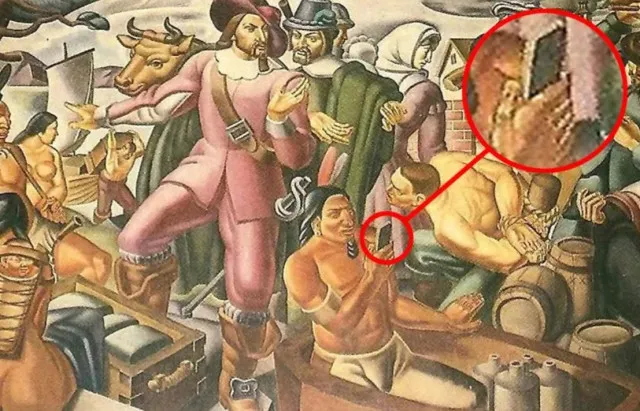Art has always been a portal into the past, but what if it also offers a glimpse into the future? That’s the question buzzing around Umberto Romano’s 1937 painting, Mr. Pynchon and the Settling of Springfield. This mural, meant to depict a historical moment from the 17th century, contains a small but peculiar detail: a Native American man appears to hold an object that eerily resembles a modern smartphone. Could this be evidence of time travel—or is it simply a trick of the eye? Let’s dive into the enigma.
The Historical Significance of the Painting
 Umberto Romano created Mr. Pynchon and the Settling of Springfield to commemorate the founding of Springfield, Massachusetts, by William Pynchon in 1636. The painting depicts settlers and Native Americans interacting, offering a rich tableau of historical life during a pivotal moment in early American history.
Umberto Romano created Mr. Pynchon and the Settling of Springfield to commemorate the founding of Springfield, Massachusetts, by William Pynchon in 1636. The painting depicts settlers and Native Americans interacting, offering a rich tableau of historical life during a pivotal moment in early American history.
While the mural focuses on the cultural and social exchanges of the time, one specific detail has taken on a life of its own: a Native American man holding an enigmatic object. At first glance, it might appear innocuous, but to modern eyes, it looks astonishingly like a smartphone.
Debunking the Time Travel Theories
While the idea of time travel is undeniably entertaining, experts and historians have weighed in with more plausible explanations.
- A Polished Mirror: Many believe the object is a hand mirror. Mirrors were popular trade items at the time, valued for their utility and novelty. The shine and positioning of the object align with this interpretation.
- An Axe Head: Another theory is that the man is holding an axe head, inspecting it closely. Tools like axes were essential for survival and often exchanged during trade.
- Artistic License: Some suggest Romano may have simply included an ambiguous object, not realizing it would fuel such speculation decades later.
Historians emphasize the importance of considering the context of the time. The resemblance to modern technology is likely coincidental, a result of the shapes and angles used in the artwork.
Social Media’s Take on the Mystery
 In the age of memes and viral debates, the “smartphone” in Romano’s painting has become an internet sensation.
In the age of memes and viral debates, the “smartphone” in Romano’s painting has become an internet sensation.
- Hilarious Theories: One user joked, “This guy is clearly checking TikTok for the latest dance trends.”
- Debunking Attempts: Others have tried to shift the focus back to historical realism. “It’s a mirror, people. Not a time traveler’s iPhone!” commented another user.
- Fascination with the Unknown: The debate reflects our collective obsession with mysteries and the desire to find connections between the past and present.
Whether it’s serious analysis or lighthearted fun, the painting has captured imaginations worldwide.
Romano’s Other “Technological” Artworks
Interestingly, this isn’t the only instance where Romano’s work seems to defy its time. Another piece by the artist features a woman holding what some believe resembles a modern tablet. While it’s unlikely Romano had any futuristic knowledge, these coincidences highlight the timelessness of his artistic style and the way contemporary viewers project modern interpretations onto historical works.
The Role of Perception in Art
 Why do we see what we see?
Why do we see what we see?
- Pareidolia: Our brains are wired to find patterns, often interpreting ambiguous shapes as something familiar. This phenomenon, called pareidolia, explains why we see faces in clouds or a “smartphone” in a 1937 painting.
- Modern Bias: Living in a tech-saturated world, we’re primed to associate rectangular objects with smartphones. This bias influences how we interpret historical imagery.
- Art’s Subjectivity: Art invites viewers to bring their own experiences and interpretations. What one person sees as a hand mirror, another might perceive as proof of time travel.
Romano’s painting exemplifies how art bridges past and present, sparking conversations that transcend its original context.

